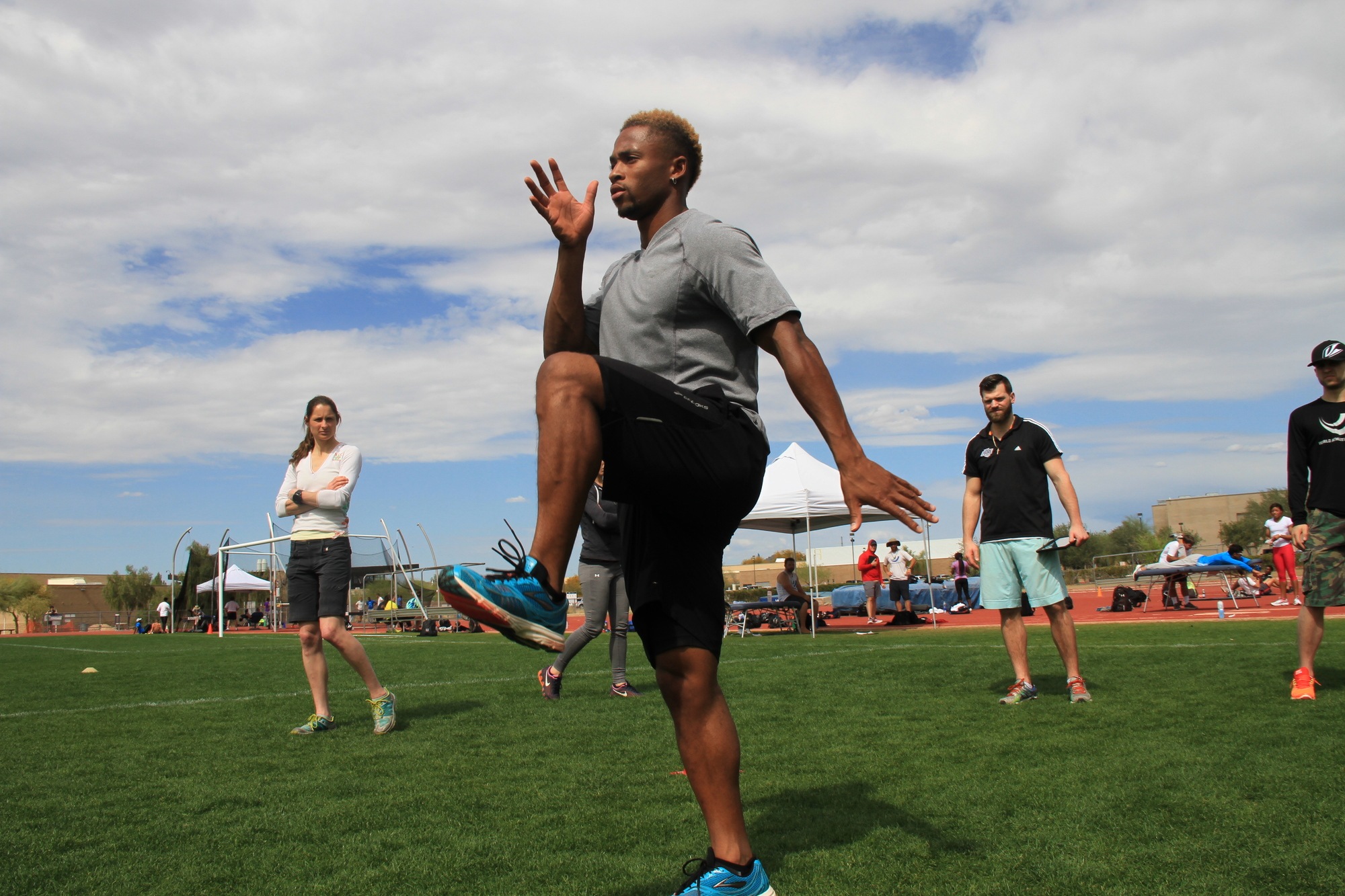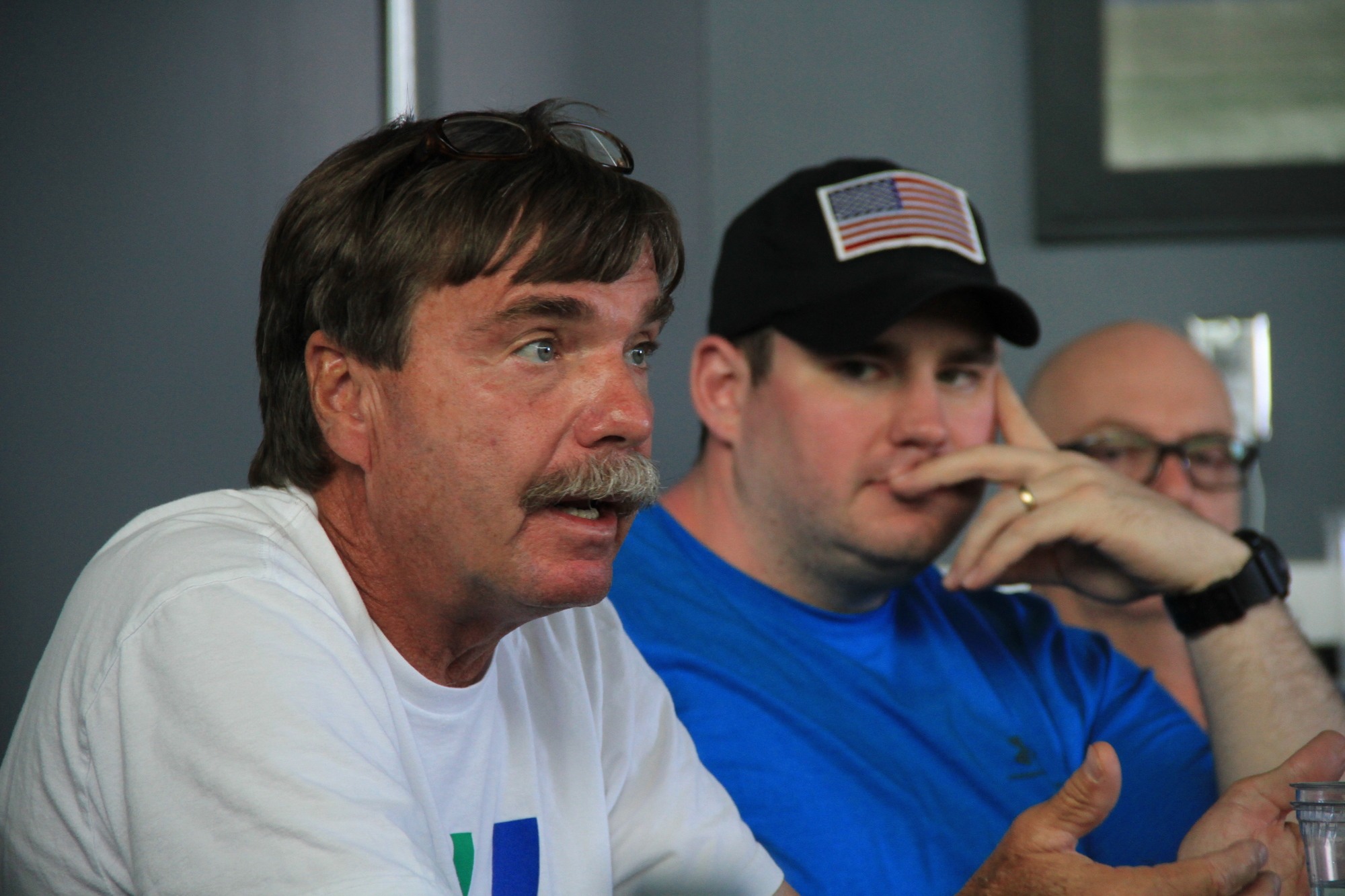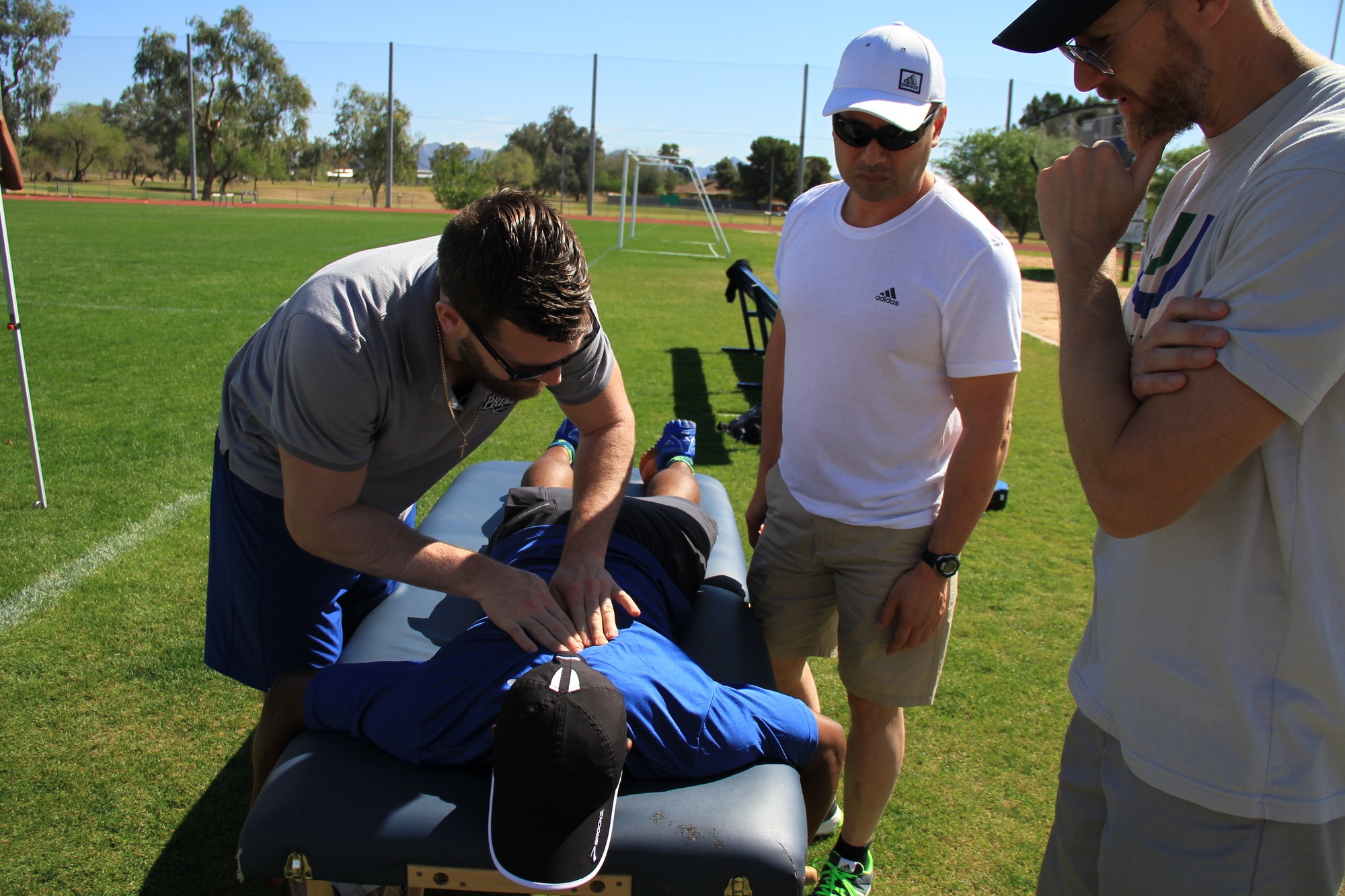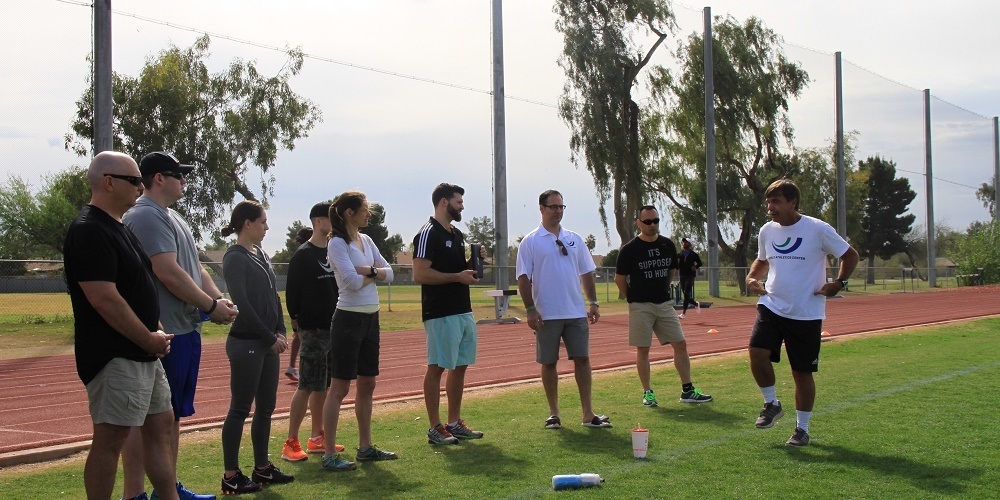Following hot on the heels of the March edition of the Gill Athletics Apprentice Coach Program, this past weekend saw the successful conclusion of the second Athletigen Performance Therapy Program.
Over the four day program, Athletigen PTP guests were treated to a world-class line up of lectures featuring WAC Medical Director – Dr Gerry Ramogida; Director of Education – Coach Dan Pfaff; and guest speaker – Dr Anthony Mascia. The trio delivered six lectures on cutting-edge topics ranging from movement screens, to biomechanics, to PRP and Radiology – in addition to the hands-on trackside sessions.
If you were unable to follow our live commentary via Twitter, we have picked out some of the highlights below. However, even better – there are a few places remaining on the April edition of the PTP, giving you the opportunity to join us in person. As Dr Ramogida explained: “The best part of the Athletigen PTP program is the openness and sharing. The collaboration of knowledge from providers and coaches from around the globe truly enriches all of our experiences, and gives participants the opportunity to get involved practically – on world class athletes.”
To share this unique collaborative experience with us, starting in just under three weeks – click here.
The Athlete-Coach-Therapist Triad – Gerry Ramogida
The performance triad = coach + athlete + therapist.
Mechanics are the currency of communication.
Less injury = consistent training + improved performance.
Foot function and intrinsic strength is often ignored. Should be part of the paradigm.
Mechanics often velocity dependent – how well do athletes move at various speeds?
Warm up lateral walks are used to observe foot, pelvic, and shoulder function & symmetry.
Plan B protocols utilize dribble series to re-introduce sprint mechanics & velocities.
“Young coaches learning to observe – try to see one joint first, then two, then more and more.”
Dr Gerry Ramogida
When watching the hip axis in lateral movements – can you see internal/external rotation, compensations?
PRP and Radiology in Elite Sport – Dr. Anthony Mascia
PRP is a biological adhesive, analgesic and wound healer.
Goal of PRP – decrease tissue healing time with improved tissue quality.
PRP has been shown superior to many other treatment methods – allowing true restoration of tissue quality.
The best surgeon hands in the world cannot be more precise than imaging with PRP.
6 weeks after UCL tear we have seen pitchers throwing 90mph again – utilizing PRP.
With PRP you will see more gradual and long lasting improvements – eventually back to 100%.
PRP is equal in effect with acute, long term, and chronic injury.
The Living Movement Screen – Gerry Ramogida
Return of rear leg in sprinting is reflexive.
As speed increases, the gastrocnemius and soleus act isometrically to transfer force.

Dr Gerry Ramogida
Foot and pelvis are often drivers of global movement patterns.
The body/fascial trains do not operate in isolation – example: thoracolumbar junction.
Often shoulder dysfunction is related to contralateral hip dysfunction.
Notice head posture, gaze, even hand tension in seemingly simple lateral walk.
Warm up is a time for athlete and coach to FOCUS on mechanics – not just get warm.
Dribbles used to train foot stiffness, amplitude, and is a cyclical/symmetrical movement.
There is an ELDOA for nearly every synovial joint in the body.
Introduction to Sprint Based Biomechanics – Dan Pfaff
You could say I’m OCD about set up – that’s because too much can go wrong right from start.
Shoulder and hip axis must angulate and oscillate in harmony for effective mechanics.
What is critical to monitor in the sprint model? Have to have versus want to have.
Seeing motion is tough – it’s a process that does not happen overnight and must be a 3D view.
Cue systems – be flexible!
“We are an error detection & correction company … don’t get bogged down in drills”
Dan Pfaff
Training theory considerations – include acceleration, speed, & speed endurance as comparative & complementary tasks.
Poolside chats
In dribble series – we are looking for concentric circles and symmetry. @PfaffSC
Changes in postures and positions effect recruitment patterns. @PfaffSC
Tissue quality varies even among athletes of similar event groups. @PfaffSC
Rudiment jump series reinforces proper lower leg mechanics, amortization times & postures. @PfaffSC
Tests of mobility almost always trump tests of position. @PfaffSC
It’s important that we work toward stability without forcing it – you can’t rush the body. @PfaffSC

Dr Gerry Ramogida
There is a hydraulic component to joints – they are fluid filled – almost piston like. @DrGerryRamogida
Coaching cues are like clothes – try on a few pairs to see what fits. @PfaffSC
There is no magic bullet – reduction to “a way” is often sub-optimal. @PfaffSC
With joint dysfunction comes improper force management on jumping, sprinting, throwing, etc. @DrGerryRamogida
Timelines are artificial – continually evaluate min effective dose, operate in real task intensities. @PfaffSC
Mechanics are important – therefore we always safeguard them via therapy pre, during & post session. @PfaffSC
Athletes have many batteries – physiological, emotional, concentration, etc. Be aware of interplay. @PfaffSC
Ultra slow motion video exposes the true nature of force transmission. @DrGerryRamogida
Critical to understand the interconnected nature of muscle tissue, fascia, bone, etc. @DrGerryRamogida

Stuart McMillan
Acceleration mechanics: a complex skill that should be practiced throughout year. @PfaffSC
Make sure your coaching is harmonious with athlete’s age, skill set, ability level
@PfaffSC
We encourage ALL young coaches to learn-practice therapy … putting your hands on the athletes gives you added information. @StuartMcMillan1
Without the medical team on-board, coach & athlete performance will be compromised. @DrGerryRamogida
What’s the trigger to dysfunctional movement? If extreme – it’s usually a conspiracy of a bunch of things. @PfaffSC
Classic model – therapists are taught WHAT it is – not WHY it is. Doesn’t work in elite sport. @builtbyscott
Ability to effectively integrate as a TEAM is the key to staying healthy and performing optimally. @builtbyscott

Dr Gerry Ramogida
Micro-movement dictates macro-movement; the role of multi-articular foot is CRITICAL. @DrGerryRamogida
Many layers of the foot determine proper micro-function and up-stream mechanics. @DrGerryRamogida
As therapists – we should moderate modality & pressure based on tissue quality and situation.
Marcin
The goal of Plan B training – modify plan to always accomplish the primary training goal. @_trackside_
We start treatment gentle, then work into more aggressive manipulation if necessary. @DrGerryRamogida
Cannot underestimate viscera and gut health in therapy practice – neurotransmitter/immune system hub. @DrGerryRamogida
Unfortunately, surgeons view fascia as something that gets in the way … bad implications for return to sport. Marcin
Our therapeutic screening process is integrated into the warm up & training process. @StuartMcMillan1

Dan Pfaff
Sleep, hydration, and nutrition are the platform on which high performance is built. @DrGerryRamogida
During competitive season – prescribe strength exercises the athletes are VERY good at. @CoachSanAndreas
High performance model = integrated – medical model = isolated – integration is key. @StuartMcMillan1
What do we REALLY know? No excuse for dogma. @builtbyscott
Recognise WHY something is stiff/rigid – be careful of what you are affecting, and downstream effects. @builtbyscott
Perfect symmetry does not always mean better performance – functional asymmetries do occur. @PfaffSC
Don’t want to create change too quickly, therapy is a gradual slide towards optimal. @StuartMcMillan1
Hallmark of patient/athlete assessment is sacro-iliac joint function. @DrGerryRamogida

Scott Livingston

